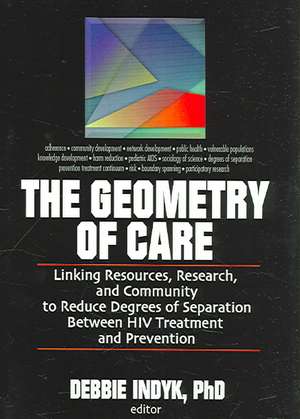The Geometry of Care: Linking Resources, Research, and Community to Reduce Degrees of Separation Between HIV Treatment and
Editat de Debbie Indyken Limba Engleză Paperback – 10 iul 2006
An effective strategy to deal with the AIDS epidemic is to have a wide range of scientists, clinicians, front-line workers, and clients distribute theory, care, and resource knowledge geometrically through all levels. The Geometry of Care: Linking Resources, Research, and Community to Reduce Degrees of Separation Between HIV Treatment and Prevention shows how to link bottom-up and top-down approaches to advance care, services, resources, training, theory, and policy analysis. Leading authorities draw upon behavioral and organizational theory to discuss the development of the frameworks necessary to effectively disseminate knowledge to benefit those needing care and to protect the community from further risk.
The Geometry of Care builds a powerful case for the development of sustained links among academic resources and the community. Practical strategies are provided to set up a dynamic response framework to integrate the latest advances in treatment and prevention. The first section focuses on System and Program Level Geometry, the second on Patient and Provider Level Geometry. This is the book that shows how to meet the challenge to effectively understand, diagnose, treat, and prevent AIDS simultaneously on multiple fronts.
Topics in The Geometry of Care include:
- expanding strategic care to include patient, community, and medical centers
- the assessment, dissemination, and integration of new advances
- the bottom-up development of links among providers, systems, and settings
- increased communication through the network of generalists and specialists within hospitals
- examples of infrastructure building at a family health service, a medical center-based AIDS center, and a home-based ambulatory care program
- how sustained setting/site relationships help to foster customized interventions
- serving clients better by tracking them through data management
- integration of prevention and treatment for clients dealing with multiple co-morbidities
- forging links between Western and traditional medicine
- tailoring prevention strategies to fit the individual
- shifting the locus of care to the HIV-positive individual
- an inter-organizational approach to supporting patient-provider interaction
- understanding barriers to adherence
- HIV as a family disease—and the geometry of care as a family issue
- the need for partnership between patient and primary care provider
- individuals with HIV and their instrumental role in prevention and transmission
- much, much more!
Preț: 317.95 lei
Preț vechi: 407.97 lei
-22% Nou
Puncte Express: 477
Preț estimativ în valută:
60.85€ • 63.16$ • 50.74£
60.85€ • 63.16$ • 50.74£
Comandă specială
Livrare economică 03-17 martie
Doresc să fiu notificat când acest titlu va fi disponibil:
Se trimite...
Preluare comenzi: 021 569.72.76
Specificații
ISBN-13: 9780789032126
ISBN-10: 0789032120
Pagini: 274
Dimensiuni: 152 x 229 x 17 mm
Greutate: 0.41 kg
Ediția:1
Editura: Taylor & Francis
Colecția Routledge
Locul publicării:Oxford, United Kingdom
ISBN-10: 0789032120
Pagini: 274
Dimensiuni: 152 x 229 x 17 mm
Greutate: 0.41 kg
Ediția:1
Editura: Taylor & Francis
Colecția Routledge
Locul publicării:Oxford, United Kingdom
Cuprins
Chapter 1 Overview of Issue, Debbie Indyk; Part 1 SYSTEM- AND PROGRAM-LEVEL GEOMETRY; Chapter 2 The Rationale of Interorganizational Linkages to Connect Multiple Sites of Expertise, Knowledge Production, and Know ledge Transfer: An Example from HIV/AIDS Services for the Inner City, David A. Rier, PhD, Debbie Indyk, PhD; Chapter 3 Wiring the HIV/AIDS System: Building Interorganizational Infrastructure to Link People, Sites, and Networks, Debbie Indyk, PhD, David A. Rier, PhD; Chapter 4 Collecting Data Along the Continuum of Prevention and Care: A Continuous Quality Improvement Approach, Leonard Indyk, PhD, Debbie Indyk, PhD; Chapter 5 A Community-Based Organization's Integration of HIV and Substance Abuse Treatment Services for Ex-Offenders, Danielle Strauss, MPH; Chapter 6 Culture, Community Networks, and HIV/AIDS Outreach Opportunities in a South Indian Siddha Organization, Kaylan Bahan, Scott Ikeda, Deeangelee Pooran, Nils Hennig, MD, PhD, Debbie Indyk, PhD, Henry Sacks, MD, PhD, George Carter; Chapter 7 Requisites, Benefits, and Challenges of Sustainable HIV/AIDS System-Building: Where Theory Meets Practice, Debbie Indyk, PhD, David A. Rier, PhD; Part 2 PATIENT-LEVEL GEOMETRY: ADHERENCE AND UNCERTAINTY–THE CHALLENGE OF PRACTICING CHANGE WHILE CHANGING PRACTICE; Chapter 8 The Shifting Locus of Risk-Reduction: The Critical Role of HIV Infected Individuals, Debbie Indyk, PhD, Sarit A. Golub, PhD; Chapter 9 Flexible Rigidity: Supporting HIV Treatment Adherence in a Rapidly-Changing Treatment Environment, David A. Rier, PhD, Debbie Indyk, PhD; Chapter 10 Shaping Garments of Care: Tools for Maximizing Adherence Potential, Ann Boyer, MD, Debbie Indyk, PhD; Chapter 11 Reframing HIV Adherence as Part of the Experience of Illness, Sarit A. Golub, PhD, Debbie Indyk, PhD, Milton L. Wainberg, MD; Chapter 12 Pediatric HIV Adherence: An Ever-Evolving Challenge, Jocelyn Childs, LCSW, Nancy Cincotta, LCSW; Chapter 13 Patient-Provider Relationships, HIV, and Adherence: Requisites for a Part nership, Arlyn Apollo, MD, MPH, Sarit A. Golub, PhD, Milton L. Wainberg, MD, Debbie Indyk, PhD; Chapter 14 HIV-Infected Individuals as Part ners in Prevention: A Redefinition of the Part ner Notification Process, Sarit A. Golub, PhD, Debbie Indyk, PhD; Chapter 15 The STARK Study: A Cross-Sectional Study of Adherence to Short-Term Drug Regimens in Urban Kenya, Ann E. Ellis, BSE, Rebecca P. Gogel, AB, Benjamin R. Roman, BA, James B. Watson, MPH (candidate), Debbie Indyk, PhD, Gary Rosenberg, PhD;
Descriere
An effective strategy to deal with the AIDS epidemic is to have a wide range of scientists, clinicians, front-line workers, and clients distribute theory, care, and resource knowledge geometrically through all levels. The Geometry of Care: Linking Resources, Research, and Community to Reduce Degrees of Separation Between HIV Treatment and Prevention shows how to link bottom-up and top-down approaches to advance care, services, resources, training, theory, and policy analysis. Leading authorities draw upon behavioral and organizational theory to discuss the development of the frameworks necessary to effectively disseminate knowledge to benefit those needing care and to protect the community from further risk.
